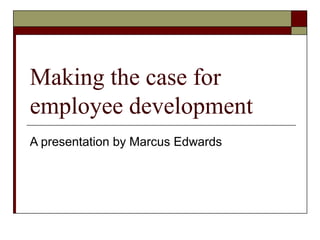Report
Share

Recommended
These are the presentation slides from a workshop at the CCS Alumni event at Cumberland Lodge, Windsor Great Park in January 2016.
They key subject for exploration and discussion was "In a world that is Volatile, Uncertain, Complex and Ambiguous (VUCA), how can we help organisations and employees have a flexible and responsive approach to career development?"Agile Career Development - How can we help organisations and employees adapt ...

Agile Career Development - How can we help organisations and employees adapt ...Antoinette Oglethorpe
Recommended
These are the presentation slides from a workshop at the CCS Alumni event at Cumberland Lodge, Windsor Great Park in January 2016.
They key subject for exploration and discussion was "In a world that is Volatile, Uncertain, Complex and Ambiguous (VUCA), how can we help organisations and employees have a flexible and responsive approach to career development?"Agile Career Development - How can we help organisations and employees adapt ...

Agile Career Development - How can we help organisations and employees adapt ...Antoinette Oglethorpe
Career Planning & Development, Jan Shine, Paullus Consultancy

Career Planning & Development, Jan Shine, Paullus ConsultancyAssociation of University Administrators
More Related Content
What's hot
Career Planning & Development, Jan Shine, Paullus Consultancy

Career Planning & Development, Jan Shine, Paullus ConsultancyAssociation of University Administrators
What's hot (20)
Career Planning & Development, Jan Shine, Paullus Consultancy

Career Planning & Development, Jan Shine, Paullus Consultancy
Human Resoruce - Training and development (GSK Glaxosmithkline India)

Human Resoruce - Training and development (GSK Glaxosmithkline India)
Similar to Making the case for employee development
Similar to Making the case for employee development (20)
Overview of the Effect of Employee Training on Organizational Perf.docx

Overview of the Effect of Employee Training on Organizational Perf.docx
The impact of employee training and development on employee

The impact of employee training and development on employee
Employee development and its affect on employee performance

Employee development and its affect on employee performance
Making employee training and development a tool for efficiency and effectiven...

Making employee training and development a tool for efficiency and effectiven...
Impact of on job training on performance of telecommunication industry

Impact of on job training on performance of telecommunication industry
Study on effectiveness of training and development

Study on effectiveness of training and development
Making the case for employee development
- 1. Making the case for employee development A presentation by Marcus Edwards
- 2. “Successful employee development requires a balance between an individual's career needs and goals and the organization's need to get work done.” (The University of Minnesota, 2008)
- 3. Why is employee development beneficial? It retains leaders and self-starters as well as innovators of the a company or organization Perfomance Improvement (Six Sigma, 2012) When employees return from training they are able to immediately apply the knowledge they have learned Challenges most employees to move out of their comfort zone and “try something new.” (Frank, 2012) Gives the employees a sense of value (Six Sigma, 2012) Training is expensive in most facets, therefore if an employer is willing to send someone on a training it makes them feel important Employee development maximizes the potential of all individuals in an organization
- 4. Employee development initiatives that need consideration Mentorships This provides the experienced worker with a less-experienced worker to work as a team for a specified amount of time. Job Rotation This provides the worker with a new responsibility every few months. Therefore challenges are renewed and workers are able to gain new perspectives Employee reimbursement This is a great opportunity because it empowers the worker to pursue additional skills and educational opportunities on their own and the company pays for it
- 5. Positive Meaning According to Pace (2010): Individuals need to have a purpose in their job If workers view their job as a career they are more likely to perform better Companies should reinforce the benefits produced for others and emphasize contribution goals more than achievement goals
- 6. Conclusion Employers should invest in employee development because it is cheaper to retain an employee than it is to hire someone from the outside.
- 7. References Employee development. (2008). Retrieved from http://www1.umn.edu/ohr/toolkit/development/index.html. Frank, J. (n.d.). Six tips for developing your employees. Retrieved from http://www.evancarmichael.com/Human-Resources/807/Six-Tips-f . Pace, A. (2010). UNLEASHING POSITIVITY IN THE WORKPLACE. T+D, 64(1), 40-44. The benefits of employee development. (2012). Retrieved from http://www.sixsigmaonline.org/six-sigma-training- certification-information/the-benefits-of-employee- development.html.